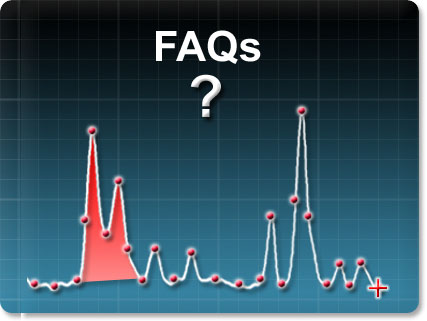

FAQs
Frequently Asked Questions | Plot Digitizer
Q. How long does it take to digitize a plot?
A. The time required depends largely upon the quality and complexity of the original image. A simple graph can be automatically digitized in less than a minute, while more complex graphs may require additional user interaction and time.
Q. Does UN‑SCAN‑IT digitize colored lines?
A. Yes. UN‑SCAN‑IT can differentiate lines and symbols based upon color or grayscale values. This can be very useful in separating data lines or symbols of different color or intensity.
Q. What is the resolution of the UN‑SCAN‑IT digitized data?
A. UN‑SCAN‑IT operates at full scanner resolution. In other words, a 10 inch graph scanned at 300 dots per inch (dpi) will yield 3,000 data points. UN‑SCAN‑IT is not limited to screen resolution. In addition, the resolution can also be increased or decreased using a cubic spline or linear fit built into the UN‑SCAN‑IT software.
Q. What if the original graph has grid lines?
A. Although grid lines can confuse the Automatic Line Follow mode there are generally some simple solutions. The UN‑SCAN‑IT software has grid line filters that can recognize (and ignore) grid lines based upon the intensity, thickness, or horizontal/vertical nature of the grid lines. In addition, if the grid lines are thinner or a lighter color than the data line, most scanners (or photocopy machines) can be adjusted to drop out the grid lines while retaining the data line. If the grid lines are particularly difficult, you can erase the grid lines just where they touch the top surface of the data line, or use Manual Mode (Auto-x-Increment) where UN‑SCAN‑IT moves automatically in the x direction and the user controls the y movement.
Q. What if the graph contains multiple curves?
A. If the curves do not intersect, UN‑SCAN‑IT will follow each curve automatically. If the lines do cross, you can use color differentiation to follow the desired line, or the software can be automatically paused at the intersection points and digitizing resumed just beyond the intersection point. Then a cubic spline fit can fill the gap. In addition, UN‑SCAN‑IT has a Semi-Automatic Mode that can be used for intersecting lines or dashed and dotted lines.
Q. Does UN‑SCAN‑IT require orthogonal axes?
A. Yes, UN‑SCAN‑IT assumes standard orthogonal (perpendicular) axes. Curvilinear and circular axes charts are much more difficult to accurately assign (x,y) values, and UN‑SCAN‑IT does not have features specific to these types of graphs.
Q. Does UN‑SCAN‑IT work with non-linear scales?
A. UN‑SCAN‑IT will work linear, semi-log, and log-log scales. Non-linear and Non-log formats must be input logically...
Example: Jan 1 to Dec 31 should be entered as Day 1 to Day 365
Example: 10:00am to 2:30pm should be entered as Hour 10.0 to Hour 14.5
Q. Does UN‑SCAN‑IT digitize PDF files?
A. UN‑SCAN‑IT does not currently digitize PDF files. PDF files often contain multiple pages, imbedded text, and variable dpi settings, which can present difficulties in extracting accurate and useful digitized data. The PDF file should be converted to a standard image format (TIFF, JPG, BMP, GIF, etc.).
Q. How does UN‑SCAN‑IT compare to similar products?
A. Since we introduced UN‑SCAN‑IT in 1992, we have worked to make UN‑SCAN‑IT the most accurate and easy to use digitizing software of it's kind. Not only has this software nearly eliminated the need for manual digitizing tablets, but our users have commented that the UN‑SCAN‑IT software is the most powerful and easy-to-use digitizing software they have used.
Other Resources
Click Here for UN‑SCAN‑IT References, Reviews, and Testimonials...
Click Here for UN‑SCAN‑IT Screenshots...





